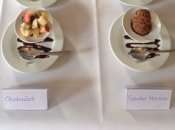Ordering food by iPad leads to healthier choice

Imagine you are in a restaurant and you can choose between a healthy fruit salad or a high-calorie chocolate mousse. If you order orally, chances are high that you will go for the high-calorie chocolate mousse. However, if you order a dish via button pressing, for instance, you are more likely to opt for the fruit salad.
This is the outcome of research by Anne-Kathrin Klesse, Assistant Professor of Marketing at Tilburg University, Jonathan Levav (Stanford University), and Caroline Goukens (Maastricht University) that was recently published in the American Journal of Consumer Research.
In their contribution titled 'The Effect of Preference Expression Modality on Self-Control', the authors describe to what extent the way in which a preference is expressed – orally, in writing, or by clicking or pressing a button – affects our self-control.
Respondents were offered a choice between unhealthy (high-calorie) or healthy (low-calorie) food in various settings, including a restaurant. They had to communicate their preference orally or manually (writing, taking or button pressing). All experiments showed that, if a choice was communicated orally, respondents preferred the hedonically temptation option (i.e., the high-calorie snack or desert). When respondents expressed their preference manually, the healthier option won out. With one exception, though: when the preference had to be expressed in a foreign language, respondents opted more frequently for healthy than for unhealthy food.
As far as the researchers are aware, this is the first study on the effects of expression modalities on consumer decisions. Clearly, more factors play a role than previously thought. The conclusions can have great impact for companies who switch from oral, face-to-face sale to online sale, where consumers choose via mouse click. With the results of this study, entrepreneurs can influence consumers' choices. In fact, restaurants that have introduced innovative ways to take orders, e.g., by means of iPads, might implicitly influence their clients' choices, stimulating them to select healthier meals. Market researchers whose insights are based on the assumption that expression modalities do not affect the choices of respondents expressed in surveys should reconsider their starting points.
Examples include telephone surveys: they may show different scores from written questionnaires. An interesting future research line could focus on the question of whether the expression modalities also affect decisions involving non-food articles.
More information: Anne-Kathrin Klesse et al. The Effect of Preference Expression Modality on Self-Control, Journal of Consumer Research (2015). DOI: 10.1093/jcr/ucv043
















